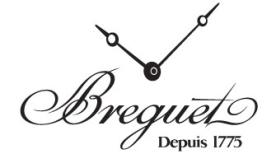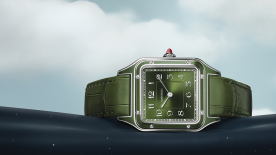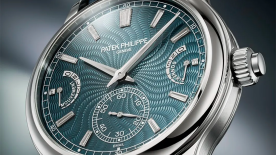WORLDTEMPUS – 21 avril 2011
Elizabeth Doerr and Louis Nardin
Dictated by its difficult geometrical shape, the egg remains a rarity in modern watchmaking. But historically speaking, it is the egg that gave birth to modern portable watches. Starting with what is known as the Nuremberg Egg, it shows up from time to time –now notably in modern interpretations by the likes of Ladoire and Breguet.
Historians are pretty much unanimous in citing the Nuremberg Egg as the first portable watch. Peter Henlein's watch, ran reliably for about 48 hours, with its diameter of about six centimeters is pinpointed as the first miniaturized mechanical clock. Tambours, considered fashionable, were worn around the neck at that point in time. Now on display in Nuremberg's Germanic National Museum, this drum (or tambour) watch was made in the mid-1500s.
Fabergé
Peter Carl Fabergé, born into a Huguenot refugee family in 1846 in St. Petersburg, was famed for his enamel and jewelry. Between 1885 and 1916, Fabergé (named official court jeweler in 1910) created more than fifty egg-shaped Easter gifts for the czar family, most of which were commissioned as surprises. The first egg, a chicken's egg, was a gift from Czar Alexander III to his Danish wife, known by her Russian name as Maria Feodorovna. The last egg, made in the year of the October Revolution, was named the War Egg.
Victor Mayer, Fabergé's last workmaster, situated in Pforzheim, Germany, created a new generation of eggs beginning with the first post-revolutionary example, which was presented to Mikhail Gorbachev as he received the Nobel Peace Prize in 1991.
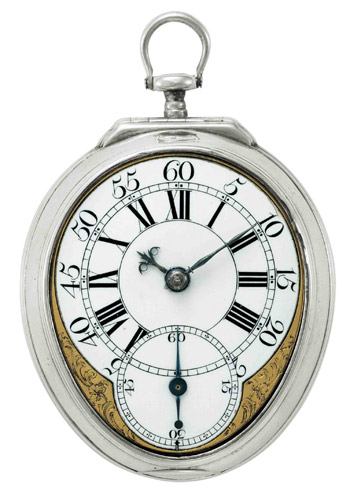
The most horologically complicated egg was completed in collaboration with master watchmaker Paul Gerber of Zurich: the Moon Phase Clock Egg from 2001, a limited edition of twelve pieces. Made of gold, onyx, rock crystal, and rose quartz, the body of the egg was crafted in hand-guilloché gold and completed with translucent light blue enamel. The moon phases are shown on a navy blue enameled sky with gold leaf stars. The white gold moon is set with paved diamonds and onyx to display the moon phases. The movement created by Gerber is an eight-day mechanical movement outfitted with twin spring barrels, a swan-neck fine adjustment, and a Breguet overcoil balance spring. The hours are visible in a window made of rock crystal on the side of the egg, while the minutes can be seen on the gold ring located directly above it. Every day at noon, “Clair de Lune” by Claude Debussy sounds from a musical movement found hidden in the gold-and-onyx pedestal.
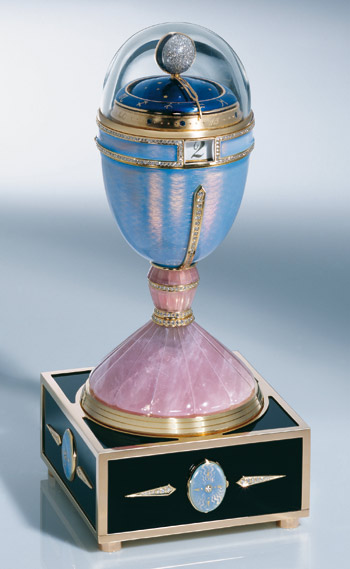
Russian honor
Honoring the Russian market, Ulysse Nardin released two very limited watch editions housed in enameled eggs crafted by an internationally famous contemporary Russian jeweler, Andrei Ananov of St. Petersburg. Two Eggs of the Tsars were released: one honoring the Kremlin (2005) and one honoring St. Petersburg (2009).
Queens and kings
Breguet is the first brand to have reproduced the egg shape in a wristwatch: the Queen of Naples, introduced in 2002. Reserved for females—fitting since it is they who reproduce life with the help of eggs—Breguet's Queen of Naples has become a popular part of the high jewelry collection, reinvented anew every year.
There is also an egg for men containing the king of complications thanks to pre-Richemont Minerva: the Tourbillon Heures Mystérieuses came out in 2005 and morphed into Montblanc's Grand Tourbillon Heures Mystérieuses in 2009 after the takeover.

The oblong shape of the egg seems to also be finding a home in the futuristic places that watchmaking is now heading. Ladoire's Rolling Guardian Time was designed by Lionel Ladoire and became a signature element of his boutique brand's look – particularly in 2008 when Ladoire debuted thanks to the more opulent angles and structures of the case, which have meanwhile softened a bit.
The latest example is, of course, Hublot's Key of Time. Like a science fiction novel, this model was reborn from the remains of BNB's demise and has now taken on an entirely different, post-modern look – reminiscent of an egg.
And, speaking of rebirth, Zenith naturally pops to mind. The Christophe Colomb, whose case is round, contains a sapphire crystal with two half-globes protruding from either side. The effect, particularly of the rotating escapement inside, is decidedly egg-shaped.
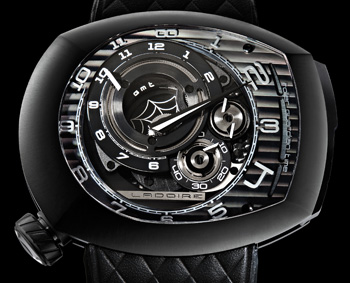
These sorts of Easter eggs have always been accompanied by a certain price. Henlein's Nuremberg Egg is priceless. Zenith's Christophe Colomb, a limited edition of 25 pieces, goes for something like 210,000 Swiss francs, and Breguet's Queen of Naples starts at around 15,000 Swiss francs and heads into the clouds with the addition of jewels and complications.
Rest assured you probably won't find them in your Easter basket on Sunday.


